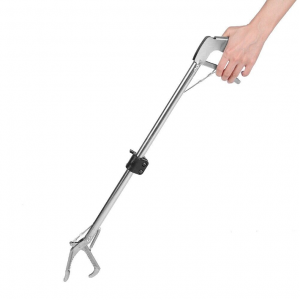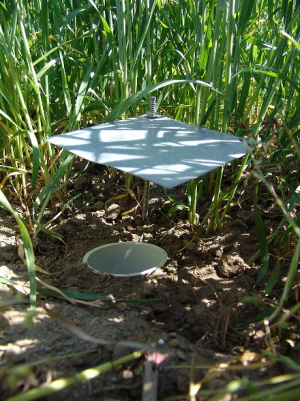Reptiles

Quantitative - Qualitative
Deductive - Inductive
Individual - System - Global
Past - Present - Future
In short: Hand-capturing, noosing and trapping are methods for counting reptiles.
Table 1. The applicability of the methods hand-capturing, marking individuals and trapping for different groups of reptiles (modified after Sutherland 1996).
+ = method often applicable, * = method usually applicable
| Hand-capturing | Marking individuals | Trapping | |
| Snakes | * | * | |
| Lizards | * | * | + |
| Crocodilians | * | * | |
| Turtles and Tortoises | * | * | + |
Contents
Hand-capturing
What the method does
Hand-capturing is the simplest method for catching reptiles. It involves intensive searching in microhabitats and catching reptiles by hand. Small lizards and snakes can be found in potential shelter sites such as under rocks or logs. Unconventional habitats like sheets of scrap metal and car bodies that are falling apart can also yield good results due to the reptiles' attraction to the sun-warmed metal. Therefore, placing tin sheets of the same size in sunny spots and regularly checking underneath them is a good method to standardize reptile sampling. While turning around stones or pieces of metal, it is recommended to wear gardening gloves to protect against cuts, bites, and stings from arthropods. Precautions should be taken to avoid getting bitten by venomous snakes if they are present in the survey area. When lifting logs or rocks, it is recommended to turn them towards the fieldworker so that the reptile remains on the other side of the object. To search for reptiles in cracks or holes, a small handheld torch or a mirror can be used to provide visibility without casting shadows. Hand-held rakes or improvised sticks are useful for searching under leaf litter when turning rocks or logs. Geckos, which often cling upside-down to rocks, require examination of the undersurface of rocks and leaf litter in their habitats. It is important to return all logs and rocks to their original positions to minimize disturbance to the habitat. Apart from capturing reptiles while they are hiding under cover, many lizards and snakes can also be counted or captured during their activity periods. For diurnal species, mid-morning is a good time to search for reptiles as they bask in the sun to elevate their body temperature. Slowly walking with the sun at the back and frequently scanning microhabitats can increase the chances of finding the desired species. Nocturnal species can be located using torchlight, and some species like geckos can be identified by their dull eye reflection. Ultraviolet light can be used to detect fluorescent species like Diplodactylus maini.
The easiest method to catch lizards or non-venomous snakes is to pounce on them with an open, cupped hand, ensuring not to crush them. With species that practice tail autotomy, the fieldworker needs to be especially cautious as they should not be held by the tail. Gloves can be helpful in preventing bites, even from non-venomous species. Venomous snakes can be caught by pinning them behind the head using a Y-shaped stick with padded forks. Larger venomous species may also be handled by the tail and then pinned down by the neck. Snake tongs, which are large forceps operated by a trigger-grip, can also aid in capturing snakes (Figure 1). It is important to avoid using sticks without padding, as they may harm the snake. Handling venomous snakes requires skill and experience, and fieldworkers should practice handling non-venomous snakes and have knowledge of first-aid procedures specific to the snake families they may encounter.

Once a lizard or snake is caught, data can be recorded immediately before releasing it or placing it in a bag for later processing. Cloth bags are suitable for larger specimens and plastic bags can be used for smaller ones.
Strengths and challenges
Hand-capturing is a relatively quick and easy way to capture small lizards and snakes. However, it is a labor-intensive method. To successfully capture reptiles from shelter sites, appropriate cover is necessary. Additionally, some of these capture techniques may cause destructive effects on the habitat and other organisms. Care must be taken to minimize disturbance and ensure that the survey method does not bias subsequent estimates. This is especially crucial when surveying rare or endangered reptiles, as the survey itself should not contribute to the species' extinction or harm other organisms. Additionally, obtaining the necessary permits from wildlife and land management authorities is essential before conducting the survey. Moreover, it can be challenging to standardize the way of capturing among different fieldworkers.
Marking individuals
What the method does
Marking individuals is a method which is suitable for all kinds of reptiles. When conducting mark-recapture procedures to estimate reptile populations, it is essential to provide each captured individual with a unique mark for identification upon recapture. The selection of a specific marking technique depends on the natural history of the study species and often requires some experimentation for optimal results. Marks can be applied to reptiles for varying durations, including short time periods, longer time periods, or even permanently. To achieve a large number of mark combinations, coding systems are commonly employed (Woodbury 1956). One of the simplest and most easily implemented techniques involves painting a mark on each animal using paint. For this purpose, nail polish is recommended. This allows for the creation of a color-coding system, facilitating easy identification. The most often used technique used to mark small lizards involves the removal of toes from one or more feet using sharp fingernail scissors. By numbering the feet and toes, a significant number of combinations can be generated, depending on the chosen coding system. For permanent marking, scales on lizards or snakes can be clipped and cauterized using a small hand-held soldering iron. In such cases, the scales either do not regrow, or they grow back in a different color, typically white, if the underlying pigment layer has been destroyed. Another alternative method is to mark animals using a hot or cold branding iron. Turtles and tortoises can be marked by cutting notches in the edge of the carapace, while crocodiles and alligators can be marked by removing tail scutes. Reptiles can also be tattooed using a small tattoo gun. Moreover, passive integrated transponder (PIT) tags for reptile marking (Camper and Dixon 1988, Keck 1994) are available. These tags can be inserted under the skin or in the abdominal cavity of small individuals. Each tag possesses a unique code that can be read using a hand-held scanner, making them effective tools for permanent reptile marking.
Strengths and challenges
Each marking technique has its advantages and disadvantages to consider. Paint marking, for example, does not physically harm the animal, but it may make individuals more visible to predators. However, the paint typically wears off after several days, making it only useful for short-term studies. When deciding on an appropriate marking procedure, it is crucial to take into account the natural history of the species. For instance, toe removal would be considered a cruel and inappropriate procedure for highly arboreal lizards or those with thick, fleshy toes. However, many terrestrial species appear to be unaffected by toe removal. It is important to note that most of the aforementioned marking methods involve physically altering the animals, resulting in marks that are longer lasting or permanent. Nevertheless, precautions should be taken to ensure the well-being of the animals during the marking process. Techniques such as tattooing or toe removal for permanent marking should only be carried out by experienced and trained herpetologists or under the supervision of a veterinarian. Fieldworkers must be mindful of ethical considerations when conducting reptile population censuses, as obtaining accurate data often requires a certain level of interference with animal populations. In cases where required by law, study methods should be submitted to the appropriate animal ethics committee for approval.
Trapping
What the method does
Trapping is a method especially useful for small reptile species. Terrestrial reptiles are commonly captured using pitfall traps, which involve sinking a bucket into the ground until the lip is on the same level as the surface. To provide shelter for the captured animals, a small layer of leaf litter or other cover can be added to the trap. This cover also serves the purpose of attracting arthropods, which act as bait for lizards. Instead of buckets, cans, plastic tubes, or milkshake cups can be used as substitutes, but the diameter and depth of the trap should be considered as they can influence the size and species composition of trapped reptiles. Some experimentation with pitfall trap design may be necessary. For instance, James (1989, 1991) utilized buckets measuring 330 mm in diameter and 450 mm deep to study seven sympatric skink species, with adult body sizes ranging from 35 mm snout-vent length (SVL) to 100 mm SVL. When the traps are left in place, lids should be fitted to prevent animals from falling in between census periods. If used in forested or wooded areas, the traps can be filled with sticks, allowing any animal that enters the trap to climb out using the sticks. In high-rainfall regions, it is essential for the pitfall traps to have drainage holes in the bottom to prevent water accumulation. However, the drainage holes should not be large enough for animals to crawl through and take refuge beneath the trap. Pitfall traps (Figure 2) can be strategically placed near logs, rocks, or other habitat features frequented by lizards or snakes. Alternatively, they can be combined with drift fences to enhance capture success. Drift fences, typically made of inexpensive flexible materials like polythene, are low fences (approximately 30 cm high) held erect by pegs. They are buried a few centimeters into the soil to prevent animals from burrowing underneath. Drift fences run along a trap line, guiding reptiles towards the traps. As reptiles encounter the fence while crawling through the survey area, they follow it in search of a way around it, eventually reaching a pit trap where they fall in. It is crucial to use a material for the drift fence that lizards and snakes find difficult to climb, preventing them from evading capture.

During trapping studies, traps should be checked and animals processed at least once a day. In harsh environments or areas with high trap success, more frequent checks may be necessary to avoid stress and mortality of trapped animals. The spacing and size of pit traps, as well as the use of drift fences, have been extensively discussed by Friend et al. (1989) and Morton et al. (1988). It is important to exercise caution when checking traps, using a stick or gloved hand to inspect them carefully before reaching in, as there may be hidden snakes, spiders, or scorpions. In rocky areas where digging holes is not feasible, an alternative to pitfall traps is the wire funnel trap (Fitch 1987). Shaped like a lobster trap or fish trap, it consists of a cylindrical structure with a funnel at one or both ends. A drift fence leads the reptile into the funnel and then into the trap. The size of the wire-mesh traps can be adjusted based on the target species, with larger species requiring stronger traps, while smaller animals can be captured using plastic bottles with the funnel attached to the lid. For capturing freshwater turtles, baited funnel traps (Legler 1960) or drum nets prove highly effective. These traps use meat or fish as bait, with cans of sardines being a convenient option. To allow trapped turtles to breathe, the trap must be positioned so that a part of it remains above the water surface. It is crucial to emphasize the responsibility of regularly checking the traps that have been set. Lost or abandoned traps can continue catching and potentially killing animals for many decades, highlighting the need for diligent monitoring and retrieval of traps.
Strengths and challenges
Trapping offers the advantage of efficiently capturing a large number of individuals with relatively minimal effort on the part of the investigator. By standardizing trapping efforts in terms of spatial and temporal dimensions, it becomes possible to meet the assumptions of various statistical models used for estimating survival or population size. However, constructing and installing traps and drift fences at the survey site can be a time-consuming, labor-intensive, and costly process. Regular checking of traps is essential, and when not in use, traps should be properly closed or removed. It is crucial to avoid the issue of lost or abandoned traps, as they can pose a long-lasting threat to the welfare of animals at the survey site, even after the study has concluded.
Normativity
Hand-capturing: When it comes to terrestrial species, this method exhibits bias towards those that rely on cover such as logs, rocks, or bark. Consequently, it is not an effective approach for capturing species that do not utilize these specific microhabitats, such as burrowing species. Additionally, animals hiding beneath excessively heavy rocks or logs that cannot be lifted are not adequately sampled.
Marking individuals: Ambiguous or lost marks can pose significant challenges in analyzing mark-recapture data. One fundamental assumption of mark-recapture models is the uniqueness of marks, and most models assume that marks remain intact over time. Additionally, it is commonly assumed that marking individuals does not influence their behavior. Failure to meet these assumptions can lead to substantial biases in population size estimates and survival probabilities. To address mark loss, one approach is to mark individuals twice and calculate the rate of loss. However, a more favorable solution is to develop an improved marking technique specific to the species of interest.
Trapping: Traps or drift fences are effective only in capturing animals that are actively moving within the survey area. As a result, trap success rates are typically low during inclement weather or periods when reptiles are inactive. Furthermore, species that are highly sedentary in nature will not be adequately sampled using these methods.
Outlook
To assess the density and species of reptiles, first experiments with eDNA from water have already taken place. However, the results were mixed and have shown that eDNA is less suitable for census of reptiles than amphibians. The reason for this might be that animals with hard, keratinized integument do not “shed” as much DNA as mucus-covered animals (Adams et al. 2019).
Key publications
Theoretical:
Adams, C. I., Hoekstra, L. A., Muell, M. R., & Janzen, F. J. (2019). A brief review of non-avian reptile environmental DNA (eDNA), with a case study of painted turtle (Chrysemys picta) eDNA under field conditions. Diversity, 11(4), 50.
Sutherland, W. J., Editor (1996). Ecological Census Techniques - a Handbook. P. 178-180. Cambridge University Press.
Empirical:
Euliss Jr, N. H., Swanson, G. A., & MacKay, J. (1992). Multiple tube sampler for benthic and pelagic invertebrates in shallow wetlands. The Journal of wildlife management, 186-191.
References
Adams, C. I., Hoekstra, L. A., Muell, M. R., & Janzen, F. J. (2019). A brief review of non-avian reptile environmental DNA (eDNA), with a case study of painted turtle (Chrysemys picta) eDNA under field conditions. Diversity, 11(4), 50.
Camper, J. D., & Dixon, J. R. (1988). Evaluation of a microchip marking system for amphibians and reptiles. Texas Parks & Wildlife Department.
James, C. D. (1989). Comparative ecology of sympatric scincid lizards (Ctenotus) in spinifex grasslands of central Australia (Doctoral dissertation, University of Sydney).
James, C. D. (1991). Population dynamics, demography, and life history of sympatric scincid lizards (Ctenotus) in central Australia. Herpetologica, 194-210.
Legler, J.M. (1960). A simple and inexpensive device for trapping freshwater turtles. Proceedings of the Utah Academy of Science 37, 63-66.
Fitch, H. S. (1987). Collecting and life-history techniques. Snakes: ecology and evolutionary biology, 143-164.
Friend, G. R., Smith, G. T., Mitchell, D. S., & Dickman, C. R. (1989). Influence of pitfall and drift fence design on capture rates of small vertebrates in semi-arid habitats of Western-Australia. Wildlife Research, 16(1), 1-10.
Keck, M. B. (1994). Test for detrimental effects of PIT tags in neonatal snakes. Copeia, 1994(1), 226-228.
Morton, S. R., Gillam, M. W., Jones, K. R., & Fleming, M. R. (1988). Relative efficiency of different pit-trap systems for sampling reptiles in spinifex grasslands. Wildlife Research, 15(5), 571-577.
Woodbury, A.M. (1956). Uses of marking animals in ecological studies: marking amphibians and reptiles. Ecology 37, 670-674.
Sutherland, W. J., Editor (1996). Ecological Census Techniques - a Handbook. P. 178-180. Cambridge University Press. 218-226.
The author of this entry is Anna-Lena Rau.